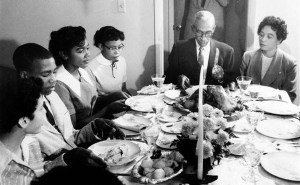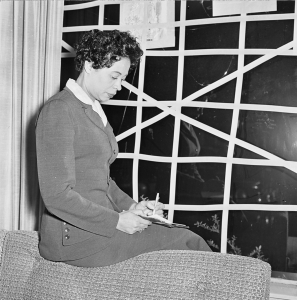We recently celebrated the Fiftieth Anniversary of the March on Washington for Jobs and Freedom, on August 28, 1963. Dr. Martin Luther King, Jr. gave his ringing “I Have a Dream” speech to an audience of around a quarter of a million people. We have all seen the footage – faces moving and dipping, upturned to hear the voices of the speakers; some people cooling their feet in the Reflecting Pool in front of the Lincoln Memorial on a hot summer’s day in DC, trousers rolled up. History in the making.
The people had marched with specific demands: The passage of meaningful civil rights legislation; the elimination of racial segregation in public schools; protection for demonstrators against police brutality; a major public-works program to provide jobs; the passage of a law prohibiting racial discrimination in public and private hiring; a $2 an hour minimum wage; and self-government for the District of Columbia, which had a black majority. A year later, Congress did pass the Civil Rights Act of 1964. But it was a long, hard road to get that far; much longer than a day’s march.
The U.S. Embassy in Kingston last week aired Sharon La Cruise’s powerful and moving film “Daisy Bates: First Lady of Little Rock” in recognition of the Fiftieth Anniversary. In her introduction, U.S. Ambassador to Jamaica Pamela E. Bridgewater recalled happy memories of that day as a teenager in Fredericksburg, Virginia. “The event was so much more than Martin Luther King’s speech,” she told us.
Where were the women on August 28, 1963? Well, they almost did not play any role at all; there was only one woman on the national planning committee for the March. Yes, the film told us something that I confess I was not fully aware of: The civil rights movement was remarkably patriarchal, as society in general was in the 1950s. The women played the role of “assistants,” rarely taking the lead. After the March was over, President John F Kennedy invited the male leaders back to the White House.
So, only three women spoke that day. They were the entertainer Josephine Baker, who had found fame in France; Rosa Parks, who had refused to move to the back of the bus; and a remarkable, but less famous woman named Daisy Bates. Bayard Rustin, an important civil rights leader who was one of the main organizers of the March on Washington, introduced her. Rustin was gay, and despite his importance to the movement he was, like Daisy Bates, somewhat sidelined because of who he was. This was the early sixties, after all.

Here’s a quote from Mrs. Bates’ speech: “We will walk until we are free, until we can walk to any school and take our children to any school in the United States. And we will sit-on and we will kneel-in and we will lie-in if necessary until every Negro in America can vote. This we pledge to the women of America.”
Ms. La Cruise’s portrait of Daisy Bates, which first aired as part of PBS’ excellent “Independent Lens” documentary series, is both sensitive and at the same time uncompromising. It was a challenging task to put together a complete picture of a very complex woman who played such a pivotal role in the civil rights movement – and in particular the desegregation of the Little Rock Central High School in 1957. She had died ten years earlier, and the filmmaker relied on the words and memories of her surviving fellow-campaigners – and her friends, who shared deep insights into her character, and her struggles.

And struggle she did, with incredible determination and strength of character. “If I am to live in this town, and live with myself,” Daisy Bates declared, “I must oppose hatred and prejudice in any way I can.” I must. And “she didn’t ask” people to do things, we learn – “she told them.” She was definitely not one of those who played an “assistant’s” part in the movement (which Rosa Parks largely did, after her initial protest action).

Photo by Will Counts; courtesy of the Arkansas History Commission
Daisy Bates was born in 1914 in the small town of Huttig, Arkansas, where a sawmill was the main employer. She learned a terrible secret as a child: Her biological mother had been raped and murdered by two local white men. Her father had subsequently abandoned her out of fear. There was “never any justice” for her mother; no proper investigation, no one charged. It is suggested that this personal tragedy spurred Daisy Bates on. As she notes in the film in her own words, from that day on “I was fighting all my life.”
In the film, we see Mrs. Bates as a powerful woman, driven, never giving up. She was never in the background; she pushed herself forward, and was considered by some (both black and white) as selfish, uneducated, and opportunist. She liked the sophisticated life, and she was glamorous. Yet her husband, L.C. Bates, was a devoted supporter, mentor and guide. They married in 1942, having already founded together a newspaper in Little Rock, The Arkansas State Press. Like the Bates’ marriage, the newspaper – a very early voice for civil rights – went through its share of trials and tribulations. Mrs. Daisy Bates’ life was never easy; but I don’t think she ever expected it to be. I would love to have met her.


In 1952, Daisy Bates became head of the Arkansas branch of the National Association for the Advancement of Colored Persons (NAACP). After the passage of the pivotal Supreme Court 1954 Brown v. Board of Education of Topeka ruling, the Daisy and L.C. Bates began exposing violations of the desegregation ruling. On September 4, 1957, nine African American students tried to begin class at the Central High School in Little Rock, as they were legally entitled to do. Their names were: Minnijean Brown, Terrance Roberts, Elizabeth Eckford, Ernest Green, Thelma Mothershed, Melba Patillo, Gloria Ray, Jefferson Thomas, and Carlotta Walls. They were prevented from entering. But, as we know, that was not the end of it. At the end of the school year, Ernest Green became the first African American to graduate from Central High School. Dr. Martin Luther King attended his graduation ceremony.

Mrs. Bates had taken the Little Rock Nine, as they were known, under her wing. She pushed them, encouraged them, sympathized, insisted that they were doing the right thing. As they endured insults, bullying, physical assaults and extreme provocation (“Every day inside the school was hell,” said Elizabeth Eckford) Mrs. Bates inspired and kept them focused. They probably spent more time with her than with their own parents, who were shut out of it all. But then, as the film pointed out, the parents “did not step out” and stand up for their children’s rights. Mrs. Bates did.


The last part of the film, about Mrs. Bates’ later years, made many of us dab at our eyes. In 1968, Mrs. Bates moved to the small rural community of Mitchellville in eastern Arkansas, where she worked diligently and without fanfare at improving the lives of the mainly black community. When she was honored, she was actually destitute (she used to take food home from the fancy dinners she attended). “Where is the reward?” We wonder. Is there ever a reward for a life of such sacrifice?
When she died in 1999, Mrs. Bates was the first female African American to lie in state in Arkansas. I felt moved to see schoolchildren, both black and white, lining up to place a daisy beside her casket.
The discussion among Jamaicans after the film was short but insightful. Lecturer in Transitional Justice and Political Institutions at the University of the West Indies Dr. Jermaine McCalpin said the film showed us, quite simply, “What it means to be human,” adding that civil rights equate to human rights in the modern sense. “How do we complete the circle?” he asked. Dr. Dalea Bean, who lectures at UWI’s Institute of Gender and Development Studies and declared her love of history, compared Daisy Bates to Malala in terms of bravery. Director of the African Caribbean Institute of Jamaica/Jamaica Memory Bank Bernard Jankee confessed that he was emotional when he first watched the film – “tears flowed.” Many of us in the audience empathized.
Those in the audience had much to say. Community activist Itana Henry asked whether the civil rights struggle could be compared with the current efforts by the LGBT community for respect and inclusion in Jamaican society. The panelists agreed that “We should speak out against all forms of discrimination…Human rights is the acceptance of all as human.” Human rights activist Yvonne McCalla Sobers, who was nineteen years old at the time, compared the civil rights struggle with the later struggles she and other Jamaican human rights advocates had for recognition. Mediator and attorney-at-law Donna Parchment pointed to Mrs. Bates’ community work in Mitchellville, calling her an “inspirational older woman.”
Why did I call her “Mrs. Bates” all the way through this article? Well, an incident referred to in the film made me realize those little subtleties of racism (and probably sexism, too) that she endured along with the open hostility and distrust. Daisy Bates was in a court case, during which the judge and lawyers continually referred to all the white people as “Mr.” and “Mrs.” and “Miss.” She was repeatedly addressed or referred to as “Daisy.” In the end she sat up straight and pointed out to them, loud and clear, that she is “Mrs. Bates” and wished to be addressed as such. She demanded respect.
It wasn’t just the big struggles in the civil rights war. It was the small battles such as these that Daisy Bates fought – and won. She was one of the “unsung” heroes and heroines – we know many of those in Jamaica too – and we all agreed:
“We need to tell these stories.”
Many thanks to cultural activist, author and founder of the Reggae Film Festival Barbara Blake Hannah, who recommended the film to Ambassador Bridgewater. I am only sorry Barbara could not make it to be there with us, that evening. My whole-hearted thanks to you, Barbara!

Related articles and links:
http://www.pbs.org/independentlens/daisy-bates/film.html Daisy Bates: First Lady of Little Rock: PBS Independent Lens
http://daisybatesfilm.com Daisy Bates: filmmaker’s website
http://www.encyclopediaofarkansas.net/encyclopedia/entry-detail.aspx?entryID=723 Encyclopedia of Arkansas: Little Rock Nine
http://www.nps.gov/chsc/index.htm Little Rock Central High School – National Park Service historic site
http://arstatenaacp.org Arkansas State Conference: NAACP
When was this published or revised?? Please answer asap.
LikeLike
Well, I wrote it and did not revise it. I wrote it based on research I did, to highlight this story. I was also inspired by a documentary aired by the U.S. Embassy to write it…
LikeLike